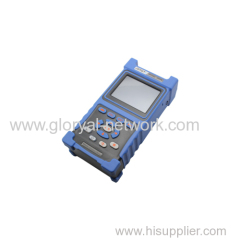Laser safety
When using this instrument, avoid eyes to look at the laser output port directly, nor look at the end of the optical fiber when testing; when the instrument is not in operation, please cover the dust cover of the optical output port.
When the visible red light of the instrument is on, please do not look at the output port of the red light directly, nor look at the end of the optical fiber at the output end of red light directly.
Instrument maintenance
1. The warranty period of the whole machine is 18 months and that of the battery is 6 months. The items accompanied with the product are not within the warranty scope.
2. The light output connector of the instrument is quick-wear part, which is not within the warranty scope.
3. If the instrument is damaged or in performance reduction caused by irresistible external factors, they will not be within the warranty scope.
4. If the instrument is damaged or in performance reduction caused by improper operation, they will not be within the warranty scope.
5. Users are forbidden to dismantle this instrument without the permission of the company or designated authorized entity; otherwise, it will lose the qualification of warranty permanently!
Ø Return of Instrument
If the product needs to be returned due to product calibration or other reasons, please contact your supplier in advance and briefly explain the reasons for product return, so as to provide effective and timely services for you.
When returning your product, please notice that:
l Pack the instrument with polyethylene and other soft thin cushion to protect the completeness of the instrument shell;
l Please use the original hard packing box. If other package is used, ensure that there is at least 3 mm thick of soft object around the instrument;
l Fill out the warranty card correctly, including the company name, address, contact person, contact phone, problem description, etc.;
l Deliver the products to the supplier's agent in a reliable way.
1. Introduction
OTDR is a precise optical measuring instrument made according to the backscatter principle of Rayleigh scattering and Fresnel reflection when the transmission of laser in the optical fiber. It can be widely used in the installation and construction, maintenance and repair and monitoring application of optical fiber and fiber cables. It can be used to measure the length, attenuation, connection quality and fault location of optical fibers and cables, etc..
When transmission of light in the optical fiber, the optical pulses in the optical fiber transmission will generate Rayleigh scattering due to the defects of optical fiber and non-uniformity of the mixed components. Of which, a part of light signal will be scattered back along the direction opposite to the incident pulse, therefore, it is called backward Rayleigh scattering. Through observing the intensity changes of backward Rayleigh scattering light signal, the loss distribution, connection quality and other features of optical fibers and cables can be accurately measured. Besides, according to the theory of optical transmission, when the light encounters the boundary of the two transmission media of different refractive indices in the transmission process (for example, connectors, mechanical connection, fracture or optical fiber termination points), Fresnel reflection phenomenon may occur. Through receiving the Fresnel reflection signal on regular basis, the position of the discontinuity points along the length of the optical fiber can be accurately determined. The size of reflection depends on the refractive index difference and boundary surface flatness.
2. Description of the OTDR test event type
OTDR test event refers to the abnormal points that may cause loss or a sudden change in the reflected power, including various types of connection and bending, cracks or fracture in the fiber link, which may cause the transmission signal loss.
The OTDR test events are mainly divided into two types: reflection events and non-reflective events.
2.1 Reflective event
When the laser pulse emitted from OTDR is transmitted along the measured optical fiber, which encounters a mechanical connection point or the end of the optical fiber, reflection phenomenon will occur due to the change of the refractive index, and some of the light energy will return along the optical fiber to the instrument. Through receiving this reflected signal, the instrument will detect this reflection event, which will be presented as upward spike signal of a certain width in the curve. The width of the spike is mainly determined by the width of the tested pulse, as shown in Fig. 2-1.




















